| Contents
Home
General
Info
Ordering
Info
Contact us
Cartridge
Lists
Patent &
Miscellaneous
US Rim Fire
US Center Fire
Pistol
US Center Fire US Rifle
Metric
British
Shotgun Shells
Pictures
Posters
Links to Other Sites
Cartridge Collectors Organizations:
IAA
ECRA
SAAACA
Auctions:
Auction
Arms
E-Bay
Ward's Collectibles
Sold USA
Books:
Armory
Publications
WCF Publications
Other Collectr's Sites:
Curtis Steinhauer
|
Home of the
Old Ammo Guy's Virtual Cartridge Trading Table
Picture
Page
May 2004
Happiness is a dirty old shipping
crate...

I have decided to devote the entire picture page for the month of May to
this Union Metallic Cartridge Company shipping crate that was found in Western
Virginia, and the boxes of cartridges that were with it. The crate is constructed
of 3/4"+ planed pine boards, held together with square cut nails. On Christmas
Eve in 1873, as attested to by the date stamped into the wood on both ends,
it was packed at UMC's Bridgeport ammunition works with fifty boxes of .50-70
Springfield cartridges, destined for the Army depot in Washington, D.C..
These were probably part of two million .50 caliber cartridges that the
government contracted with UMC to produce in late 1873.
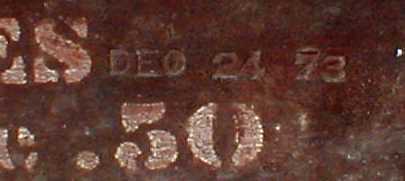 At that time,
the government arsenals were focused on production of the new .45-70 cartridge,
as the Model 1873 Springfield had just been selected as the standard for
Army use in May of 1873. Once the crate was packed and the top secured in
place, it was painted a dark red, then stenciling and the date stamps
were applied to both ends, and it was ready to be shipped. Upon arrival in
Washington, it was probably packed away and forgotten for a while. Some time
later, the top was painted gray, and addressed in black stenciled lettering At that time,
the government arsenals were focused on production of the new .45-70 cartridge,
as the Model 1873 Springfield had just been selected as the standard for
Army use in May of 1873. Once the crate was packed and the top secured in
place, it was painted a dark red, then stenciling and the date stamps
were applied to both ends, and it was ready to be shipped. Upon arrival in
Washington, it was probably packed away and forgotten for a while. Some time
later, the top was painted gray, and addressed in black stenciled lettering
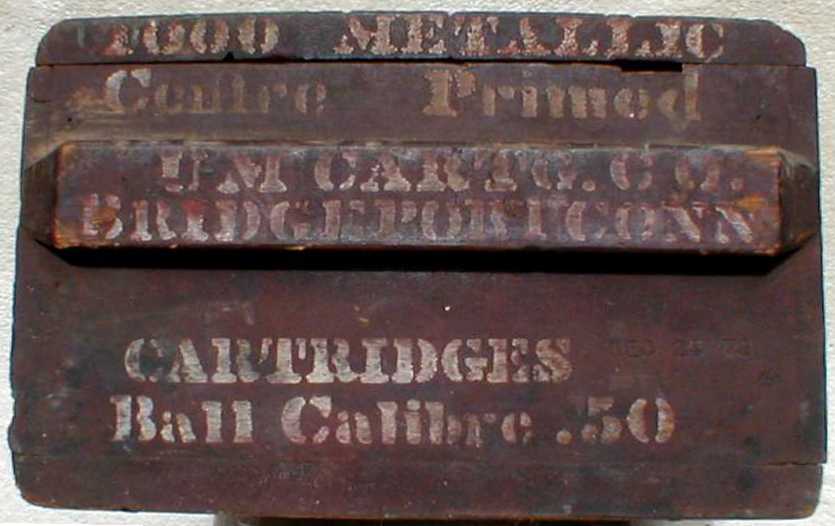 for shipment
to the Adjutant of the Virginia State Militia, in Richmond. Typically, the
guns and ammunition issued to the states were, in turn, distributed to
the various county militias. These were often stored in the county court
houses where, more often than not, they were never needed. This certainly
seems to be the case for at least a portion of the boxes that were in the
crate, as the ten unopened boxes that came with it are in excellent
condition. The fact that the original top is still with the crate would support
the likelihood that it was still screwed in place when found by the previous
owner. One opened box was also found with the crate, revealing for shipment
to the Adjutant of the Virginia State Militia, in Richmond. Typically, the
guns and ammunition issued to the states were, in turn, distributed to
the various county militias. These were often stored in the county court
houses where, more often than not, they were never needed. This certainly
seems to be the case for at least a portion of the boxes that were in the
crate, as the ten unopened boxes that came with it are in excellent
condition. The fact that the original top is still with the crate would support
the likelihood that it was still screwed in place when found by the previous
owner. One opened box was also found with the crate, revealing
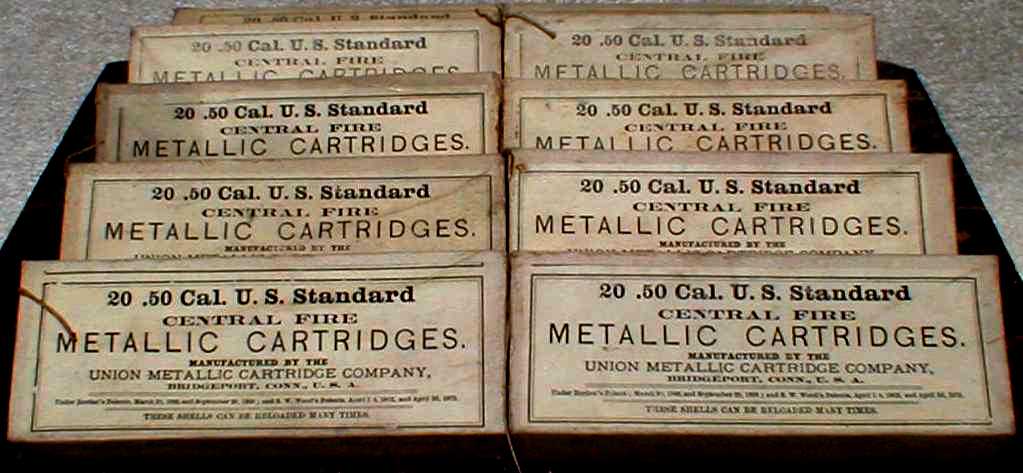 the cartridges
also to be in excellent condition. They are the Berdan primed, unheadstamped
case style with the raised ring head typical of early UMC cartridge production.
The box labels are rather plain, lacking the 'dog's head' UMC logo that was
standard on the company's ammunition intended for commercial sale during
the 1870s and 1880s. Four patent dates are printed on the labels; these include
Hiram Berdan's patents of March 20, 1866, for the external primer cap and
fixed anvil in
the the cartridges
also to be in excellent condition. They are the Berdan primed, unheadstamped
case style with the raised ring head typical of early UMC cartridge production.
The box labels are rather plain, lacking the 'dog's head' UMC logo that was
standard on the company's ammunition intended for commercial sale during
the 1870s and 1880s. Four patent dates are printed on the labels; these include
Hiram Berdan's patents of March 20, 1866, for the external primer cap and
fixed anvil in
the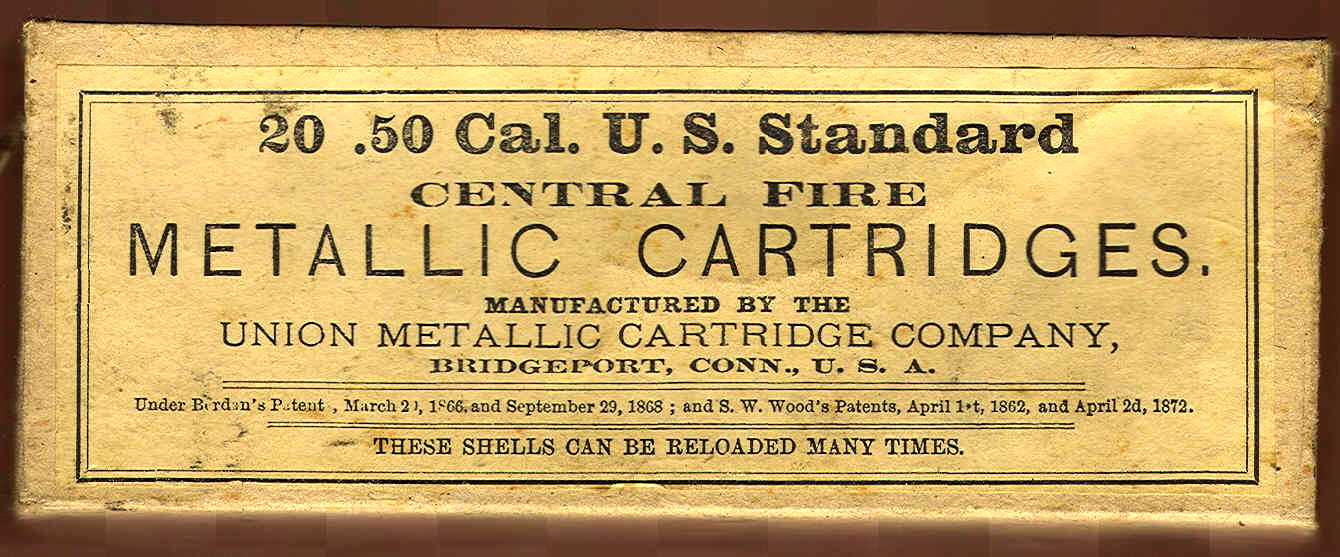 head of
the shell, and September 29, 1868, for a cup fitted inside the case
to strengthen the head. The other two are S. W. Wood's patents of April 1,
1862 and April 2, 1872, both of which I believe applied to the processes
for forming drawn brass cartridge cases. The boxes themselves are
constructed of four separate pieces of cardboard, consisting of two pieces
to form the body of the box and two end pieces, all held in place by a pasted-on
buff colored paper wrapper, with a pull string head of
the shell, and September 29, 1868, for a cup fitted inside the case
to strengthen the head. The other two are S. W. Wood's patents of April 1,
1862 and April 2, 1872, both of which I believe applied to the processes
for forming drawn brass cartridge cases. The boxes themselves are
constructed of four separate pieces of cardboard, consisting of two pieces
to form the body of the box and two end pieces, all held in place by a pasted-on
buff colored paper wrapper, with a pull string
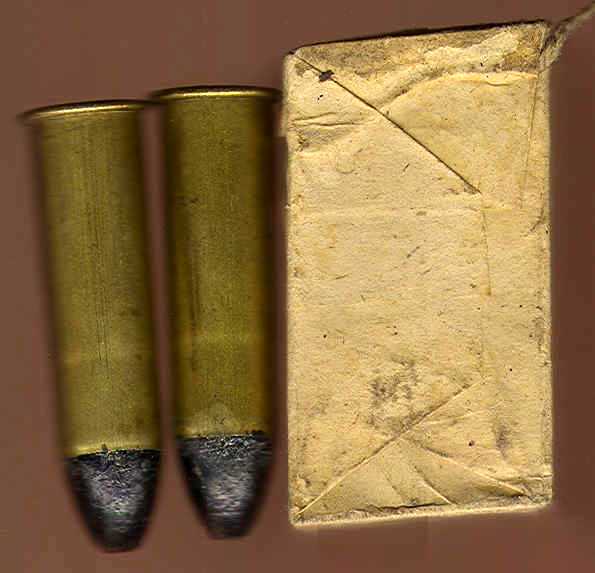 for opening
the box. When viewed from the end, as in this last picture, the top
and bottom do not form 90 degree angles to the front and back, but instead
are canted slightly. As a result, when the cartridges are placed in the box,
the bullet tips resting against the angled bottom cause the rims of the front
row of cartridges to be positioned slightly above the back row, allowing
for easier removal of the cartridges from the box. The pull string can
be seen to the upper right in the picture. Pulling this string tears the
paper wrapper across the end of the box, then across the back and the other
end. The top can then be opened and 'hinged' on the untorn wrapper along
the front top edge of the box to expose the cartridges. for opening
the box. When viewed from the end, as in this last picture, the top
and bottom do not form 90 degree angles to the front and back, but instead
are canted slightly. As a result, when the cartridges are placed in the box,
the bullet tips resting against the angled bottom cause the rims of the front
row of cartridges to be positioned slightly above the back row, allowing
for easier removal of the cartridges from the box. The pull string can
be seen to the upper right in the picture. Pulling this string tears the
paper wrapper across the end of the box, then across the back and the other
end. The top can then be opened and 'hinged' on the untorn wrapper along
the front top edge of the box to expose the cartridges.
One lazy weekend shortly after getting the crate my curiosity got the best
of me, and I set out to determine how the boxes would have to be packed in
the crate in order to fit all fifty that were originally shipped. This entailed
making up facsimile boxes which closely matched the dimensions of the originals.
At this point, two of the original boxes had found another home, so
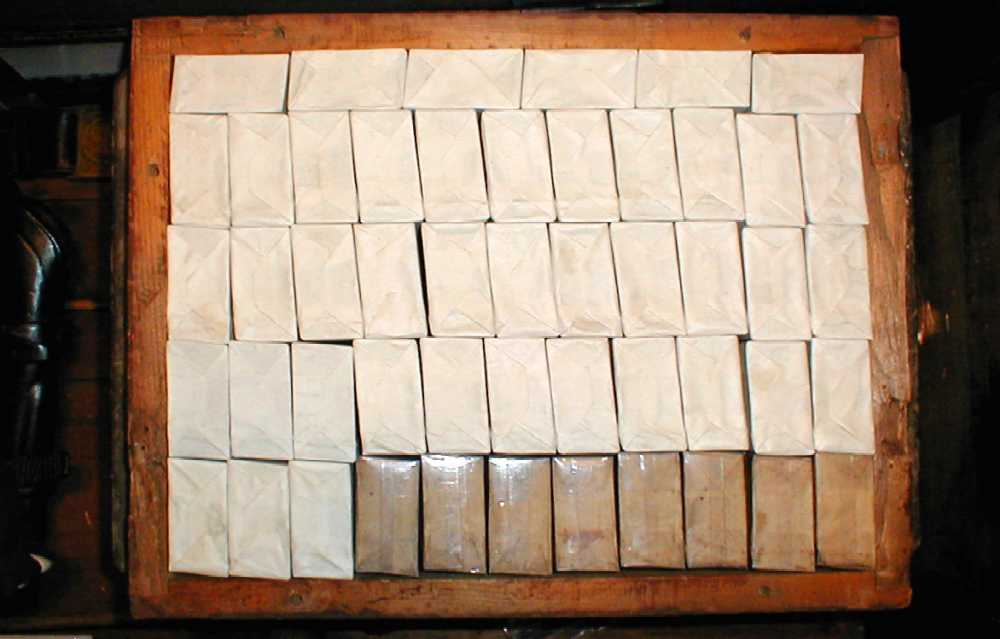 I found myself
up to my elbows in cardboard, paper and glue making the forty two replacements
need to fill the crate. Once these were completed, I found after just a little
trial and error that I could only fit all fifty boxes in by placing them
as shown in the picture, on their ends in four rows of eleven each, with
the last six turned sideways into the remaining space. Its a fairly compact
package, leaving little room for the boxes to shift around. So, how did my
facsimile boxes turn out? Not bad if I say so myself. They are not such close
copies as to be confused with the originals, but certainly good enough to
meet my needs. After I found myself
up to my elbows in cardboard, paper and glue making the forty two replacements
need to fill the crate. Once these were completed, I found after just a little
trial and error that I could only fit all fifty boxes in by placing them
as shown in the picture, on their ends in four rows of eleven each, with
the last six turned sideways into the remaining space. Its a fairly compact
package, leaving little room for the boxes to shift around. So, how did my
facsimile boxes turn out? Not bad if I say so myself. They are not such close
copies as to be confused with the originals, but certainly good enough to
meet my needs. After
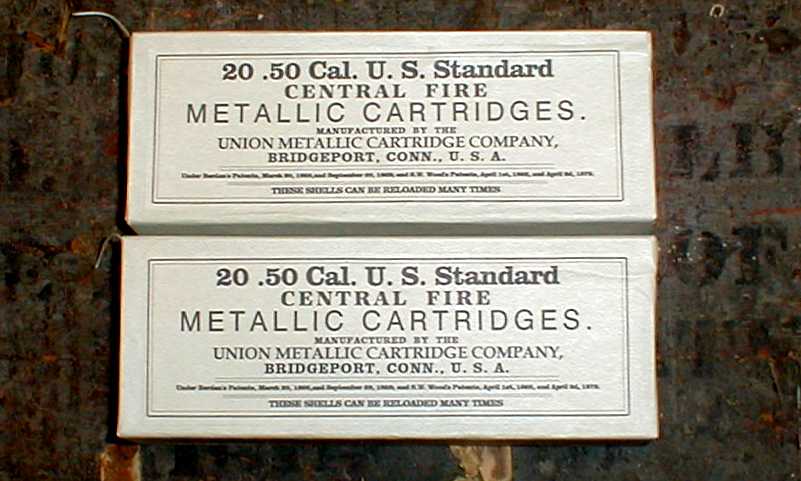 making forty
two of them, I'm not only a fairly accomplished box maker, but I also have
a better appreciation for how tedious the work must have been for the UMC
factory workers who made the company's cartridge boxes six long days a week. making forty
two of them, I'm not only a fairly accomplished box maker, but I also have
a better appreciation for how tedious the work must have been for the UMC
factory workers who made the company's cartridge boxes six long days a week.
|


 At that time,
the government arsenals were focused on production of the new .45-70 cartridge,
as the Model 1873 Springfield had just been selected as the standard for
Army use in May of 1873. Once the crate was packed and the top secured in
place, it was painted a dark red, then stenciling and the date stamps
were applied to both ends, and it was ready to be shipped. Upon arrival in
Washington, it was probably packed away and forgotten for a while. Some time
later, the top was painted gray, and addressed in black stenciled lettering
At that time,
the government arsenals were focused on production of the new .45-70 cartridge,
as the Model 1873 Springfield had just been selected as the standard for
Army use in May of 1873. Once the crate was packed and the top secured in
place, it was painted a dark red, then stenciling and the date stamps
were applied to both ends, and it was ready to be shipped. Upon arrival in
Washington, it was probably packed away and forgotten for a while. Some time
later, the top was painted gray, and addressed in black stenciled lettering
 for shipment
to the Adjutant of the Virginia State Militia, in Richmond. Typically, the
guns and ammunition issued to the states were, in turn, distributed to
the various county militias. These were often stored in the county court
houses where, more often than not, they were never needed. This certainly
seems to be the case for at least a portion of the boxes that were in the
crate, as the ten unopened boxes that came with it are in excellent
condition. The fact that the original top is still with the crate would support
the likelihood that it was still screwed in place when found by the previous
owner. One opened box was also found with the crate, revealing
for shipment
to the Adjutant of the Virginia State Militia, in Richmond. Typically, the
guns and ammunition issued to the states were, in turn, distributed to
the various county militias. These were often stored in the county court
houses where, more often than not, they were never needed. This certainly
seems to be the case for at least a portion of the boxes that were in the
crate, as the ten unopened boxes that came with it are in excellent
condition. The fact that the original top is still with the crate would support
the likelihood that it was still screwed in place when found by the previous
owner. One opened box was also found with the crate, revealing
 the cartridges
also to be in excellent condition. They are the Berdan primed, unheadstamped
case style with the raised ring head typical of early UMC cartridge production.
The box labels are rather plain, lacking the 'dog's head' UMC logo that was
standard on the company's ammunition intended for commercial sale during
the 1870s and 1880s. Four patent dates are printed on the labels; these include
Hiram Berdan's patents of March 20, 1866, for the external primer cap and
fixed anvil in
the
the cartridges
also to be in excellent condition. They are the Berdan primed, unheadstamped
case style with the raised ring head typical of early UMC cartridge production.
The box labels are rather plain, lacking the 'dog's head' UMC logo that was
standard on the company's ammunition intended for commercial sale during
the 1870s and 1880s. Four patent dates are printed on the labels; these include
Hiram Berdan's patents of March 20, 1866, for the external primer cap and
fixed anvil in
the head of
the shell, and September 29, 1868, for a cup fitted inside the case
to strengthen the head. The other two are S. W. Wood's patents of April 1,
1862 and April 2, 1872, both of which I believe applied to the processes
for forming drawn brass cartridge cases. The boxes themselves are
constructed of four separate pieces of cardboard, consisting of two pieces
to form the body of the box and two end pieces, all held in place by a pasted-on
buff colored paper wrapper, with a pull string
head of
the shell, and September 29, 1868, for a cup fitted inside the case
to strengthen the head. The other two are S. W. Wood's patents of April 1,
1862 and April 2, 1872, both of which I believe applied to the processes
for forming drawn brass cartridge cases. The boxes themselves are
constructed of four separate pieces of cardboard, consisting of two pieces
to form the body of the box and two end pieces, all held in place by a pasted-on
buff colored paper wrapper, with a pull string
 for opening
the box. When viewed from the end, as in this last picture, the top
and bottom do not form 90 degree angles to the front and back, but instead
are canted slightly. As a result, when the cartridges are placed in the box,
the bullet tips resting against the angled bottom cause the rims of the front
row of cartridges to be positioned slightly above the back row, allowing
for easier removal of the cartridges from the box. The pull string can
be seen to the upper right in the picture. Pulling this string tears the
paper wrapper across the end of the box, then across the back and the other
end. The top can then be opened and 'hinged' on the untorn wrapper along
the front top edge of the box to expose the cartridges.
for opening
the box. When viewed from the end, as in this last picture, the top
and bottom do not form 90 degree angles to the front and back, but instead
are canted slightly. As a result, when the cartridges are placed in the box,
the bullet tips resting against the angled bottom cause the rims of the front
row of cartridges to be positioned slightly above the back row, allowing
for easier removal of the cartridges from the box. The pull string can
be seen to the upper right in the picture. Pulling this string tears the
paper wrapper across the end of the box, then across the back and the other
end. The top can then be opened and 'hinged' on the untorn wrapper along
the front top edge of the box to expose the cartridges.
 I found myself
up to my elbows in cardboard, paper and glue making the forty two replacements
need to fill the crate. Once these were completed, I found after just a little
trial and error that I could only fit all fifty boxes in by placing them
as shown in the picture, on their ends in four rows of eleven each, with
the last six turned sideways into the remaining space. Its a fairly compact
package, leaving little room for the boxes to shift around. So, how did my
facsimile boxes turn out? Not bad if I say so myself. They are not such close
copies as to be confused with the originals, but certainly good enough to
meet my needs. After
I found myself
up to my elbows in cardboard, paper and glue making the forty two replacements
need to fill the crate. Once these were completed, I found after just a little
trial and error that I could only fit all fifty boxes in by placing them
as shown in the picture, on their ends in four rows of eleven each, with
the last six turned sideways into the remaining space. Its a fairly compact
package, leaving little room for the boxes to shift around. So, how did my
facsimile boxes turn out? Not bad if I say so myself. They are not such close
copies as to be confused with the originals, but certainly good enough to
meet my needs. After
 making forty
two of them, I'm not only a fairly accomplished box maker, but I also have
a better appreciation for how tedious the work must have been for the UMC
factory workers who made the company's cartridge boxes six long days a week.
making forty
two of them, I'm not only a fairly accomplished box maker, but I also have
a better appreciation for how tedious the work must have been for the UMC
factory workers who made the company's cartridge boxes six long days a week.